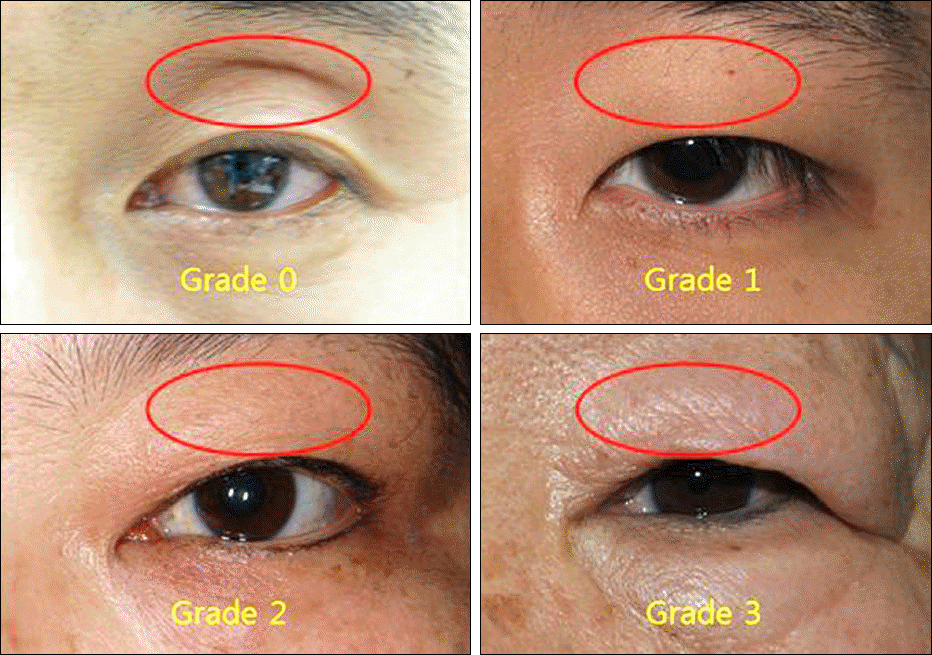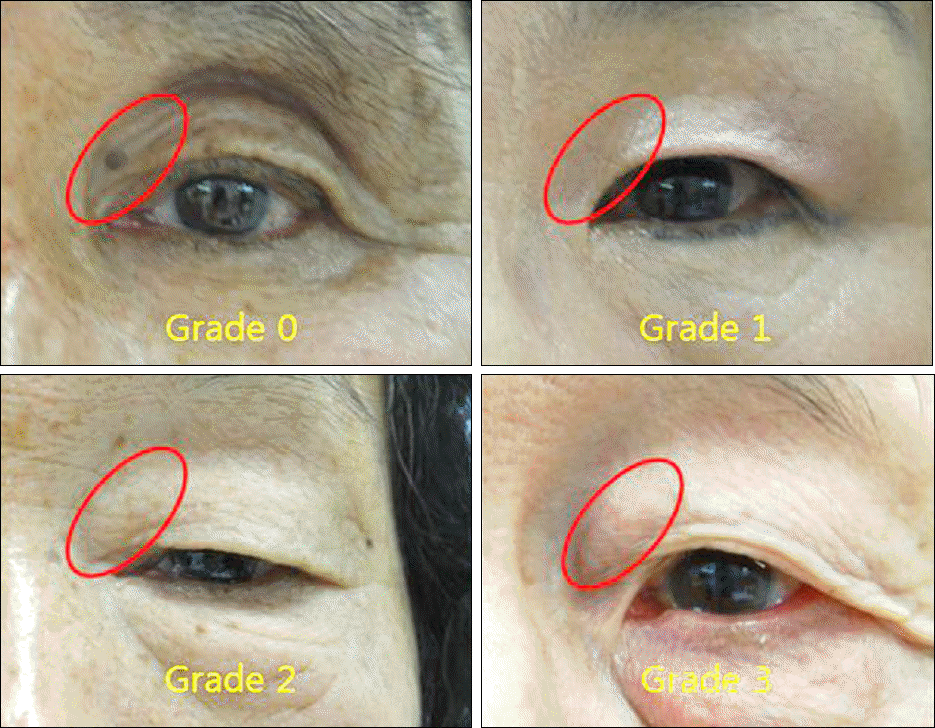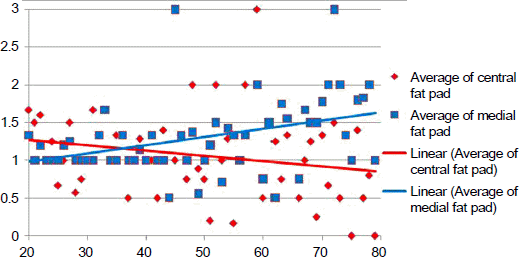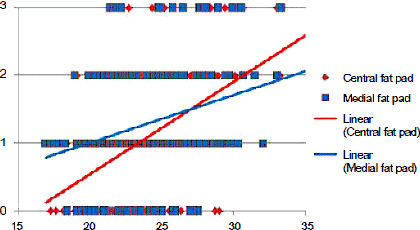Abstract
Purpose
To evaluate differential changes in the central and nasal fat pads of the upper eyelid associated with aging and the effect of body mass index in Koreans.
Methods
Using a standardized scale, the volume grade of the central and nasal fat pads was graded from 0 to 3 (0 for depressed, 1 for flat, 2 for mildly protruded, and 3 for markedly protruded) in normal adults, consisting of 20 males and 20 females from 30 years of age to 80 years of age. The body mass index was calculated for every patient through interviews using their height and weight. Statistical evaluations correlating age and body mass index with central and nasal fat pad changes were performed. Statistical evaluations correlating age with fat pad changes except for the effect of body mass index were performed.
Results
Except for the effect of body mass index, the central fat pad increased (r = -0.176, p = 0.007) and nasal fat pad decreased (r = 0.252, p < 0.001) with aging, which was statistically significant.
Conclusions
With aging, the central fat pad increases and nasal fat pad decreases in the upper eyelid. Clinically, this finding has implications in cosmetic and functional upper eyelid blepharoplasty. In addition, the results may be useful to determine whether to conserve or remove the fat as well as the amount of fat removal during upper blepharoplasty.
Go to : 
References
1. van den Bosch WA, Leenders I, Mulder P. Topographic anatomy of the eyelids, and the effects of sex and age. Br J Ophthalmol. 1999; 83:347–52.

2. Lucarelli MJ, Khwarg SI, Lemke BN, et al. The anatomy of mid-facial ptosis. Ophthal Plast Reconstr Surg. 2000; 16:7–22.

3. Lee JM, Lee H, Park MS, et al. The volumetric change of orbital fat with age in Asians. Ann Plast Surg. 2011; 66:192–5.

4. Castanares S. Blepharoplasty for herniated intraorbital fat; anatomical basis for a new approach. Plast Reconstr Surg. 1951; 8:46–58.
5. Sires BS, Lemke BN, Dortzbach RK, Gonnering RS. Characterization of human orbital fat and connective tissue. Ophthal Plast Reconstr Surg. 1998; 14:403–14.

6. Sires BS, Saari JC, Garwin GG, et al. The color difference in orbital fat. Arch Ophthalmol. 2001; 119:868–71.

7. Oh SR, Chokthaweesak W, Annunziata CC, et al. Analysis of eyelid fat pad changes with aging. Ophthal Plast Reconstr Surg. 2011; 27:348–51.

8. Kim IS, Choi JB, Rah SH, Lee SY. Classification of ptosis in Korea. J Korean Ophthalmol Soc. 2005; 46:1262–9.
9. Seo HR, Ahn HB. Morphological changes of the eyelid according to age. J Korea Ophthalmol Soc. 2009; 50:1461–7.

11. Korn BS, Kikkawa DO, Hicok KC. Identification and characterization of adult stem cells from human orbital adipose tissue. Ophthal Plast Reconstr Surg. 2009; 25:27–32.

12. Ahn HB, Seo JW, Yoo JH, et al. Epiblepharon related to high body mass index in korean children. J Pediatr Ophthalmol Strabismus. 2011; 48:57–60.

13. Ryu WY, Ko BU, Jeung WJ, Ahn HB. Analysis of age-related changes in the lower lid and soft tissue using computed tomography. J Korean Ophthalmol Soc. 2010; 51:1427–30.

14. Darcy SJ, Miller TA, Goldberg RA, et al. Magnetic resonance imaging characterization of orbital changes with age and associated contributions to lower eyelid prominence. Plast Reconstr Surg. 2008; 122:921–9.

Go to : 
Table 1.
Average central and nasal fat pad grade in each age group
| Age Group (years) | Average score for indicated fat pad | p-value | |
|---|---|---|---|
| Central | Nasal | ||
| 20-29 | 1.075 ± 0.764 | 1.100 ± 0.304 | 0.800 |
| 30-39 | 1.225 ± 0.620 | 1.150 ± 0.427 | 0.412 |
| 40-49 | 1.150 ± 0.834 | 1.050 ± 0.749 | 0.457 |
| 50-59 | 1.025 ± 0.974 | 1.200 ± 0.723 | 0.242 |
| 60-69 | 0.975 ± 1.209 | 1.300 ± 0.939 | 0.079 |
| 70-79 | 0.950 ± 0.815 | 1.850 ± 0.949 | <0.01* |
Table 2.
Average central and nasal fat pad grade in each BMI group
Table 3.
Changes of central and nasal fat pad with aging
| Correlation coefficient | p-value | |
|---|---|---|
| Central fat pad | -0.091 | 0.159 |
| Nasal fat pad | +0.273 | <0.001* |
Table 4.
Changes of central and nasal fat pad with the effect of BMI
| Correlation coefficient | p-value | |
|---|---|---|
| Central fat pad | +0.515 | <0.001* |
| Nasal fat pad | +0.307 | <0.001* |
Table 5.
Changes of central and nasal fat pad with aging, ex-cept the effect of BMI
| Correlation coefficient | p-value | |
|---|---|---|
| Central fat pad | -0.176 | 0.007* |
| Nasal fat pad | +0.252 | <0.001* |




 PDF
PDF ePub
ePub Citation
Citation Print
Print






 XML Download
XML Download